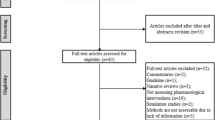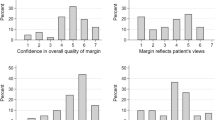Abstract
BACKGROUND: Commentators have suggested that patients may understand quantitative information about treatment benefits better when they are presented as numbers needed to treat (NNT) rather than as absolute or relative risk reductions.
OBJECTIVE: To determine whether NNT helps patients interpret treatment benefits better than absolute risk reduction (ARR), relative risk reduction (RRR), or a combination of all three of these risk reduction presentations (COMBO).
DESIGN: Randomized cross-sectional survey.
SETTING: University internal medicine clinic.
PATIENTS: Three hundred fifty-seven men and women, ages 50 to 80, who presented for health care.
INTERVENTIONS: Subjects were given written information about the baseline risk of a hypothetical “disease Y” and were asked (1) to compare the benefits of two drug treatments for disease Y, stating which provided more benefit; and (2) to calculate the effect of one of those drug treatments on a given baseline risk of disease. Risk information was presented to each subject in one of four randomly allocated risk formats: NNT, ARR, RRR, or COMBO.
MAIN RESULTS: When asked to state which of two treatments provided more benefit, subjects who received the RRR format responded correctly most often (60% correct vs 43% for COMBO, 42% for ARR, and 30% for NNT, P=.001). Most subjects were unable to calculate the effect of drug treatment on the given baseline risk of disease, although subjects receiving the RRR and ARR formats responded correctly more often (21% and 17% compared to 7% for COMBO and 6% for NNT, P=.004).
CONCLUSION: Patients are best able to interpret the benefits of treatment when they are presented in an RRR format with a given baseline risk of disease. ARR also is easily interpreted. NNT is often misinterpreted by patients and should not be used alone to communicate risk to patients.
Similar content being viewed by others
References
Institute of Medicine (US). Envisioning the National Health Care Quality Report. Washington, DC: The Institute; 2001.
Rajkumar S, Sampathkumar P, Gustafson A. Number needed to treat is a simple measure of treatment efficacy for clinicians. J Gen Intern Med. 1996;11:357–9.
Schwartz LM, Woloshin S, Black WC, Welch HG. The role of numberacy in understanding the benefit of screening mammography. Ann Intern Med. 1997;127:966–72.
Laupacis A, Sackett D, Roberts R. An assessment of clinically useful measures of the consequences of treatment. N Engl J Med. 1988;318:1728–33.
Sackett D. Inference and decision at the bedside. J Clin Epidemiol. 1989;42:309–16.
Hutton JL. Number needed to treat: properties and problems. J Royal Statist Soc A. 2000;163:403–19.
Hux JE, Naylor CD. Communicating the benefits of chronic preventive therapy: does the format of efficacy data determine patients’ acceptance of treatment? Med Decis Making. 1995;15:152–7.
Grimes DA, Snively GR. Patients’ understanding of medical risks: implications for genetic counseling. Obstet Gynecol. 1999;93:910–4.
Woloshin S, Schwartz L, Byram S, Fischhoff B, Welch H. A new scale for assessing perceptions of chance: a validation study. Med Decis Making. 2000;20:298–307.
Lipkus I, Samsa G, Rimer B. General performance on a numeracy scale among highly educated samples. Med Decis Making. 2001;21:37–44.
Woloshin S, Schwartz LM. How can we help people make sense of medical data? Eff Clin Prac. 1999;2:176–83.
Feldman-Stewart D, Kocovski N, McConnell BA, Brundage MD, Mackillop WJ. Perception of quantitative information for treatment decisions. Med Decis Making. 2000;20:228–38.
McAlister F, Straus S, Guyatt G, Haynes RB, Users’ guide to the medical literature XX. Integrating research evidence with the care of the individual patient. J Am Med Assoc. 2000;283:2829–36.
Rothman A, Salovey P, Antone C, Keough K, Martin CD. The influence of message framing on intentions to perform health behaviors. J Exp Social Psychol. 1993;29:408–33.
Bobbio M, Demichelis B, Giustetto G. Completeness of reporting trial results: effect on physicians’ willingness to prescribe. Lancet. 1994;343:1209–11.
Cranney M, Walley T. Same information, different decisions: the influence of evidence on the management of hypertension in the elderly. Br J Gen Pract. 1996;46:661–3.
Forrow L, Taylor WC, Arnold RM. Absolutely relative: how research results are summarized can affect treatment decisions. Am J Med. 1992;92:121–4.
Bucher HC, Weinbacher M, Gyr K. Influence of method of reporting study results on decision of physicians to prescribe drugs to lower cholesterol concentration. BMJ. 1994;309:761–4.
Naylor CD, Chen E, Strauss B. Measured enthusiasm: does the method of reporting trial results alter perceptions of therapeutic effectiveness? Ann Intern Med. 1992;117:916–21.
Nikolajevic-Sarunac J, Henry DA, O’Connell DL, Robertson J. Effects of information framing on the intentions of family physicians to prescribe long-term hormone replacement therapy. J Gen Intern Med. 1999;14:591–8.
National Center for Education Statistics (US). Adult literacy in America: a first look at the findings of the national adult literacy survey. Washington, DC: US Department of Education; 1993.
Author information
Authors and Affiliations
Corresponding author
Additional information
Conference Presentation: Society of General Internal Medicine Conference, San Diego, Calif, May 2001. Awarded the Mack Lipkin, Sr. Award for an outstanding presentation by an associate member.
Financial support: Dr. Sheridan was supported by a National Research Services Award (Public Health Service Grant #PE 14001-14). Drs. Pignone and Lewis were supported by the Lineberger Comprehensive Cancer Center and American Cancer Society Career Development Awards (#01-195-01 and #00-180-00).
Rights and permissions
About this article
Cite this article
Sheridan, S.L., Pignone, M.P. & Lewis, C.L. A randomized comparison of patients’ understanding of number needed to treat and other common risk reduction formats. J GEN INTERN MED 18, 884–892 (2003). https://doi.org/10.1046/j.1525-1497.2003.21102.x
Issue Date:
DOI: https://doi.org/10.1046/j.1525-1497.2003.21102.x




